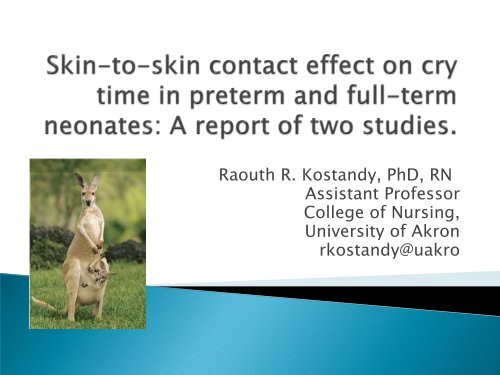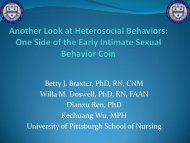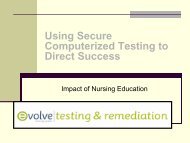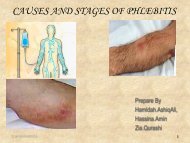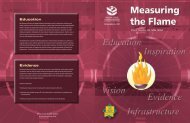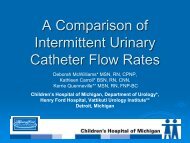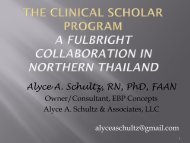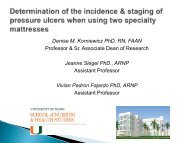Raouth R. Kostandy, PhD, RN Assistant Professor College of ... - IUPUI
Raouth R. Kostandy, PhD, RN Assistant Professor College of ... - IUPUI
Raouth R. Kostandy, PhD, RN Assistant Professor College of ... - IUPUI
- No tags were found...
Create successful ePaper yourself
Turn your PDF publications into a flip-book with our unique Google optimized e-Paper software.
<strong>Raouth</strong> R. <strong>Kostandy</strong>, <strong>PhD</strong>, <strong>RN</strong><strong>Assistant</strong> <strong>Pr<strong>of</strong>essor</strong><strong>College</strong> <strong>of</strong> Nursing,University <strong>of</strong> Akronrkostandy@uakro
A prospective cross-over design with randomassignment to having the first heel stick either in,STS, called a Skin-to-Skin heel stick (STSH) or inthe incubator, called an Incubator heel stick (IH).Neonates who had STSH first had the IH 24 h later.Neonates who had the IH first had the STSH 24 hlater. Two independent scorers <strong>of</strong> the videotapes wereblind to the purpose and design <strong>of</strong> the study. Inter-rater reliability was 0.85 as measured bykappa coefficient. The study was approved by university and hospitalInstitutional Review Boards. Written informedconsent was obtained from both parents <strong>of</strong> eachneonate in the original study.
Neonates were tested in a level II 13-bedNICU served by two neonatologists and twoneonatal nurse practitioners. Noise and lightlevels were appropriately reduced at all times.
The ten neonates reported here were one cohort inan NIH-funded multi-cohort pilot study measuringpain responses (Ludington, 2002). Inclusion criteria:1. healthy 30-32 weeks’ gestational age;2. within 2-9 days <strong>of</strong> birth;3. no signs <strong>of</strong> heel tissue inflammation;4. either NPO or fed by bolus feed (one completeamount <strong>of</strong> feeding given over 20 min); and5. being cared for in an incubator.
Exclusion criteria:1. any known congenital anomaly;2. grade III or IV intraventricular hemorrhage;3. history <strong>of</strong> surgery;4. history <strong>of</strong> drug exposure;5. any tissue breakdown or inflammation <strong>of</strong> eitherheel;6. or any sedative or analgesic within 24 h before thestudy.
Cry time was defined as the number <strong>of</strong>seconds <strong>of</strong> crying time for each phase(baseline, heel warming, heel-stick, andrecovery).
At 9:30 a.m. on the first day <strong>of</strong> study, neonateswere positioned in either STS or in the incubatordepending on the sequence to which each hadbeen randomized.20 minutes later, Baseline data collection began. Then the Heel Warming phase took place, Followed by Heel-Stick to collect blood for lab testsrequired daily. A 0.5-mL blood sample was needed and generallyrequired 1-2 min to obtain.
Recovery phase began immediately after theheel-stick site had been covered with a bandaid. At the end <strong>of</strong> Recovery, all data collectionceased and the STS neonate was placed back inthe incubator. IH: left in the incubator throughout all phases. On the second day, the procedure was thesame except that neonates who had been inSTS on the first day were in the incubator onthe second, and first-day incubator neonateswere in STS on the second day.
The number <strong>of</strong> seconds <strong>of</strong> crying for each neonatefor each phase was totaled using the mean <strong>of</strong> thetwo research assistant’s cry times for each subject. Repeated measures analysis <strong>of</strong> variance (ANOVA)was used to analyze the data, with one factor beingthe four phases and the second factor beingwhether STSH was on the first or second day <strong>of</strong> thestudy. Alpha was set at 0.05.
crying was minimal before Heel-stick, increasedduring the Heel-Stick, and declined duringRecovery, regardless <strong>of</strong> day <strong>of</strong> study. Significant differences in cry times between STSHand IH on both days were present as follows: On Day 1, STSH had less crying during Recovery (M= 5.83 seconds, SD = 7.63) than neonates in IH (M= 25.50 seconds, SD = 41.93) On Day 2, STSH neonates had significantly less crytime (M= 55.00 seconds, SD = 55.53) during theHeel-Stick phase than IH neonates (M = 96.17, SD= 92.42) (F (1,8) = 7.76, p = 0.001)
Purpose:To investigate the effect <strong>of</strong> Skin-to-Skincontact (STS) on cry time during and afterhepatitis B vaccine injection in full-termneonates. Hypothesis:During injection and recovery periods,neonates in the STS group compared tocontrol neonates will have significantly lesscry time.
Two-group open randomized controlled trial(RCT). Setting: postpartum unit <strong>of</strong> UniversityMacDonald Women’s Hospital (UMWH). The study was approved by university andhospital Institutional Review Boards. Writteninformed consent was obtained from themothers <strong>of</strong> each neonate.
36 mother-neonate dyadsMaternal Inclusion Criteria:• healthy enough to provide KCNeonatal Inclusion Criteria:• spontaneous vaginal delivery or plannedcesarean section• gestational age 37-42 weeks and birthweight <strong>of</strong> 2,500 grams)• 5-minute Apgar scores <strong>of</strong> at least 7• scheduled for hepatitis B immunization inthe hospital
Cry time was defined as the number <strong>of</strong>seconds <strong>of</strong> crying time for each phase(baseline I, baseline II, injection, andrecovery).
Obtaining IRB approvals Identifying potential subjects Obtaining maternal written informedconsent Collecting baseline I data (5 min.) inmother’s room Randomizing with minimization in mother’sroom◦ STS group: STS in mother’s room (10-15 min.)◦ Control group: supine in crib in nursery (10-15min.) Collecting baseline II data (5 min.)
Collecting injection data (1 min.) startedwhen nurse began to unwrap the neonate. Collecting recovery data (5 min.) After data collection was done- STS mothers had the choice to keep theirneonate in STS or not- Control neonates were returned to theirmother’s room
STS5 m. 1 m. 5 m.10-15 m.RARecruit.Baseline I5 m10-15 m.CBaseline II5 m.Injection1 m.Recovery5 m.
Using a stopwatch, the number <strong>of</strong> seconds<strong>of</strong> crying for each neonate for each phasewas totaled. Data were analyzed by independent sample t-test and descriptive statistics. Alpha level .05 was used.
Neonate’s Characteristics• 50% were male, 53% were African-American• 89% had a 5-minute Apgar score <strong>of</strong> 9• 61% were breastfed• Previous painful experiences• All (100%) had Vitamin K injection• 58% had heel sticks• 43% <strong>of</strong> the male neonates had been circumcised
There was no differences in cry time betweenthe STS group neonates compared to thecontrol neonates during baseline I andbaseline II.
During injection STS group neonates had asignificantly shorter cry time (M = 23.35seconds, SD = 11.26) than controls (M = 31.63 seconds, SD = 10.41), t (34) = 2.29, p =.03. During recovery STS group neonates had asignificantly shorter cry time (M =15.76seconds, SD = 18.96) than the controls (M =71.79 seconds, SD =78.31), t (34) = 3.02, p= .007
cry time in seconds80controlKC6040200injectionrecoveryMean cry time in seconds during injection and recovery periods.
STS was effective in reducing the cryingresponse to heel-stick and hepatitis Bvaccine injection pain as pain occurred andduring recovery in both preterm and fulltermneonates.
Anand, K. (2001). International evidence-based group for neonatal pain:consensus statement for the prevention and management <strong>of</strong> pain in thenewborn. Archives <strong>of</strong> Pediatrics and Adolescents Medicine, 155, 173-180.Clifford, P., Stringer, M., Christensen, H., & Mountain, D. (2004). Painassessment and intervention for term newborns. Journal <strong>of</strong> Midwifery &Women’s Health, 49(6), 514-519.Ferber SG, Makhoul IR. (2008). Neurobehavioural assessment <strong>of</strong> skin-toskineffects on reaction to pain in preterm infants: a randomized controlledwithin-subject trial. Acta Paediatr, 97(2):171-176.Gray, L., Watt, L., & Blass, E. M. (2000). Skin-to-Skin contact is analgesic inhealthy newborns. Pediatrics, 105, e14. Retrieved January 17, 2000 from theWorld Wide Web:http://www.pediatrics.org Gray, L., Miller, L. W., Philipp, B. L., & Blass, E. M. (2002). Breastfeeding isanalgesic in healthy newborns. Pediatrics, 109 (4), 590-593. Grunau RV, Holsti L, & Peters, J.W. (2006). Long-term consequences <strong>of</strong> painin human neonates. Seminars Fetal Neonatal Med, 11(4), 268-275. Hermann, C., Hohmeister, J., Demirakca, S., Zohsel, K., & Flor, H. (2006).Long-term alteration <strong>of</strong> pain sensitivity in school-aged children with earlypain experiences. Pain, 125, 278-285.
Johnston CC, et al., (2008). Kangaroo mother care diminishes pain from heellance in very preterm neonates: a crossover trial. BMC Pediatr ,8, 13-22.Ludington-Hoe, S.M. et al.,(2005). Skin-to-skin contact (Kangaroo Care)analgesia for preterm infant heel stick. AACN Clinical Issues, 16(3) 373-387.Pasero, C. (2004). Pain relief for neonates: Watching for behavior change,subtle signals in these vulnerable patients. American Journal <strong>of</strong> Nursing, 104(5), 44-47.Ramenghi LA et al., (2002). Intra-oral administration <strong>of</strong> sweet-tastingsubstances and infant’s crying response to immunization: A randomized,placebe controlled trial. Biol <strong>of</strong> Neonate 81(3), 163-169.Reis EC et al., (2003). Effective pain reduction for multiple immunizationinjections in young infants. Arch Pediatr Adolesc Med 157(11), 1115-1120.Schechter, N. (2006). Neonatal pain. Journal <strong>of</strong> Pediatrics and Child Health,42, 2-3.Taddio, A., Goldbach, M., Ipp, M., Stevens, B. & Koren, G. (1995). Effects <strong>of</strong>neonatal circumcision on pain response during vaccination in boys. Lancet,345, 291-292.Taddio, A., Katz, J., IIiersich, A. & Koren, G. (1997). Effects <strong>of</strong> neonatalcircumcision on pain response during subsequent routine vaccination.Lancet, 349, 599-603.


